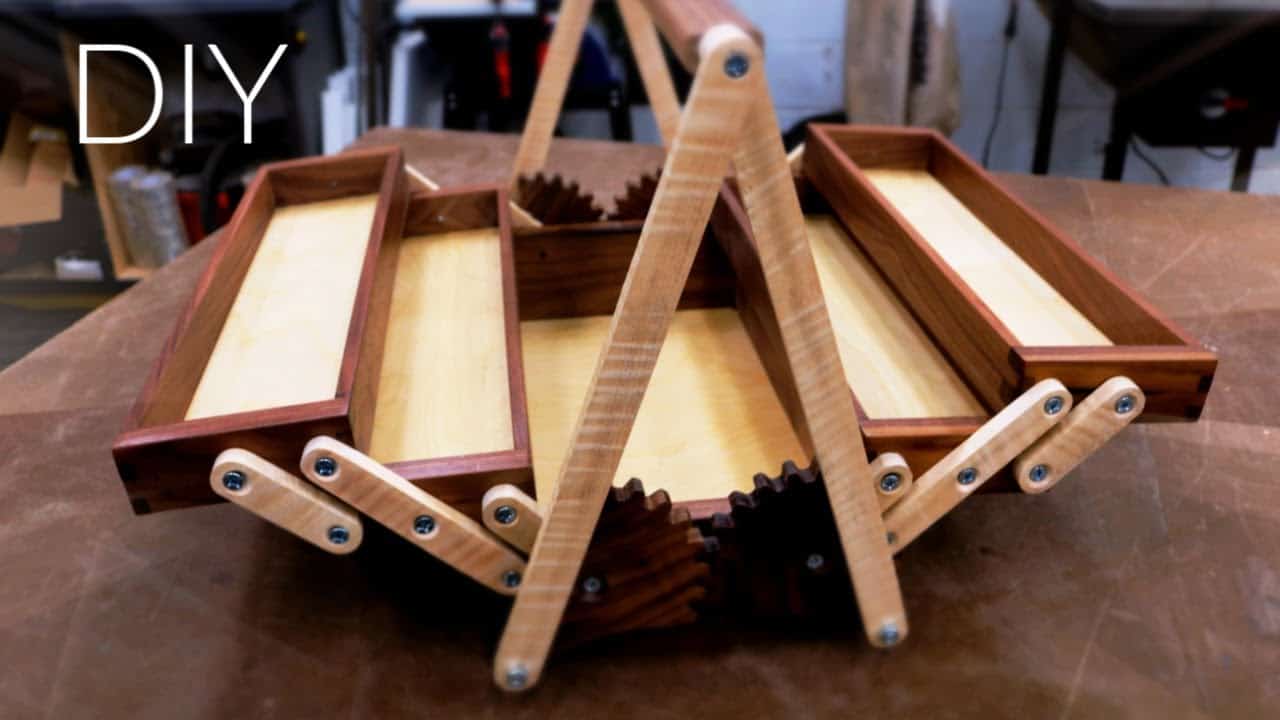This project was built and designed by Izzy Swan.
Izzy demonstrates a wooden toolbox that opens when the handle is pushed down, revealing a clever internal linkage and gear system that folds compartments outward. The video focuses on the mechanism, templates for repeatable parts, and tips for clean cutting and smooth movement.
Watch the full video and subscribe to Izzy Swan:
Design
The build centers on a folding mechanism that translates a vertical handle push into coordinated rotation of gears and linkages, so lids and trays open automatically.
Izzy balances function with aesthetics by using solid wood for the visible box and carefully shaped handles and link arms for a refined look.
The design is adaptable: the size and internal layout can be changed to suit gardening, fishing, or general tool storage without changing the core mechanism. Templates keep the geometry consistent so the parts mesh properly when assembled.
Templates and Preparation
Izzy emphasizes using printed and hard templates to cut repeatable parts, which simplifies layout and ensures the gear teeth and pivot points align. He also suggests grouping parts for drilling and routing to maintain consistency across multiple components.
Before cutting small or intricate parts, sanding and shaping larger blanks makes finishing easier and gives better control when creating the final profiles. A little setup time—dry clamping, taped templates, and drilling pilot holes—reduces fitting issues later on.
Cutting Gears and Linkages
The mechanism relies on a set of matched gear wheels and short/long link arms that pivot together to create the folding motion. Izzy cuts the gears from hardwood, trims the teeth carefully, and cleans up edges with sanding tools to ensure smooth meshing.
For the link arms, figured maple or similar hardwoods make attractive, durable connectors; countersinks and properly sized pivot holes let fasteners act as smooth pivot points. Izzy also glues small central links where needed and uses a dowel-through pivot to keep components aligned during assembly.
Assembly and Tuning
Assembly proceeds by mounting the long links, adding the short links, and finally attaching the gears so the motion is free and properly indexed. Izzy waxes moving surfaces and gear teeth to reduce friction and preserve a smooth action once assembled.
Final tuning involves checking for binding, loosening or tightening pivot fasteners, and trimming handles so they clear adjacent parts throughout the motion. Once tuned, the folding action should lift and lower cleanly with a light push on the handle.
Finishing and Practical Use
Izzy finishes components with a light wax to protect surfaces while keeping moving parts slick, and he fits internal foam or organizers based on intended use. The toolbox works equally well for fishing gear, garden tools, or general hardware storage when adapted to desired internal layouts.
Small adjustments—like slightly shortening or tapering an arm or adding a tiny clearance—make a big difference in long-term reliability, so testing the mechanism without full finish is a helpful step. The finished result is a visually appealing, highly functional toolbox that opens with a satisfying mechanical motion.
Why This Build Matters
This project is a great study in mechanical woodworking: it combines gear cutting, precision drilling, and tuned linkages with straightforward boxmaking. The techniques shown are useful beyond this project and can be adapted to folding trays, tool chests, or other moving furniture elements.
Using templates, thinking about clearances, and testing the mechanism early help builders avoid common pitfalls and produce a smooth, durable result that looks as good as it works.
The approach highlights problem-solving in the shop: purpose-driven design paired with careful fabrication yields clever, usable projects.
Please support Izzy by visiting his website: https://www.izzyswan.com/.
PLANS AND PAPER TEMPLATES – https://bit.ly/foldingtoolboxplans
